Top Compensation Management Strategies for Employee Retention
Boost retention by aligning pay strategies with goals. Balance incentives with benefits. Use tech for efficient compensation. Click for more!
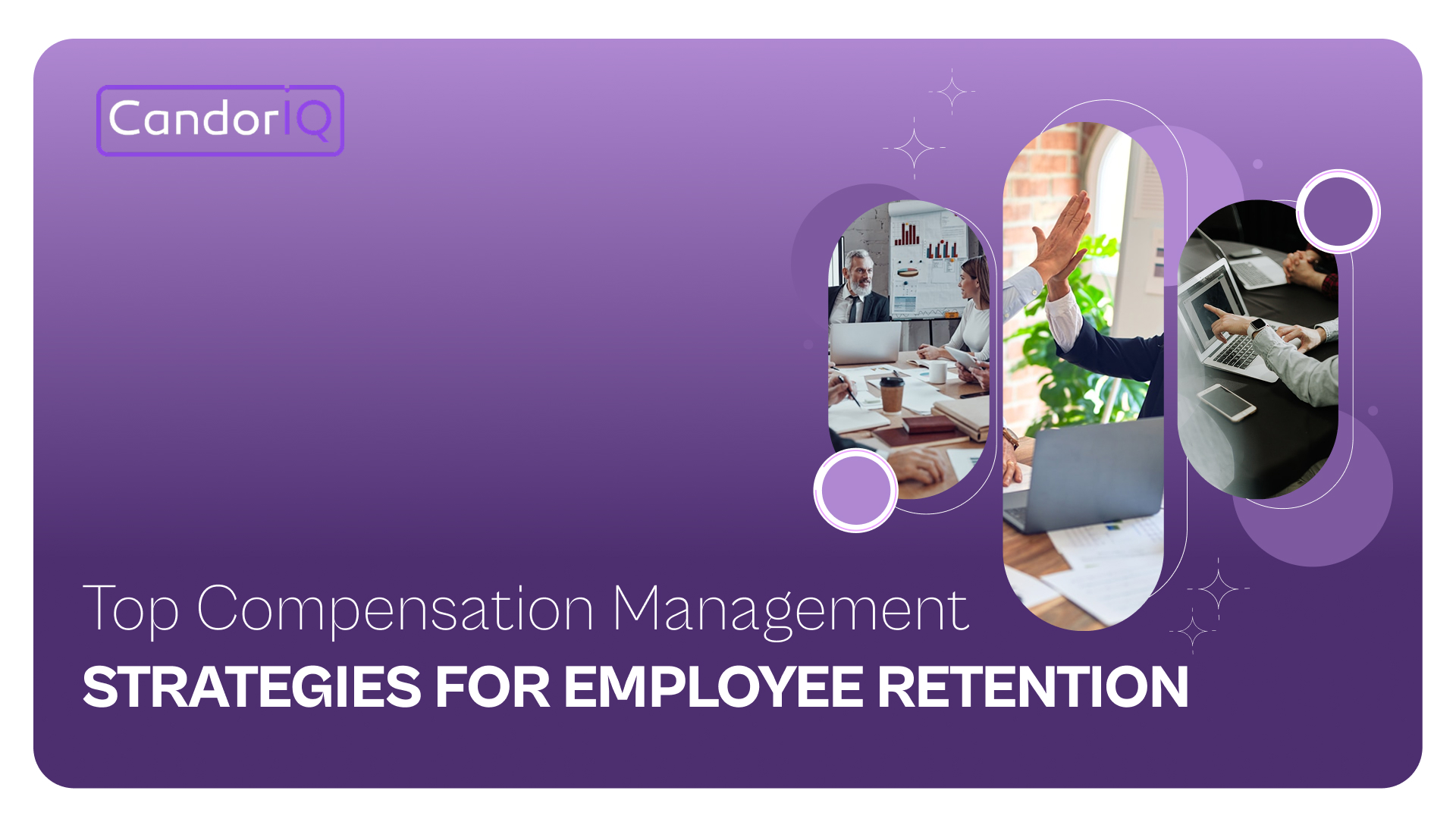
What Makes Employees Stay? It’s Not Just Culture
Compensation plays a pivotal role in shaping employee retention and morale. As organizations compete for top talent, offering fair and competitive pay isn’t just nice; it’s a strategic imperative. Without it, companies risk high turnover costs, lost productivity, and diminished engagement. Modern businesses need compensation strategies that not only attract employees but also inspire them to stay and grow. In this blog, we’ll explore proven retention tactics centered on compensation, blending industry insights with practical tips to help HR and finance leaders build a more stable and motivated workforce.
TL;DR
- Replacing an employee can cost up to twice their annual salary, making retention a financial priority
- Fair and competitive compensation is one of the top reasons employees stay or leave
- A strong compensation strategy goes beyond salary to include bonuses, equity, benefits, and transparency
- Benchmarking against market data helps prevent talent loss and pay inequity
- Structuring compensation by role, location, and tenure improves engagement and reduces early exits
- Pay transparency builds trust but requires clear communication and alignment across teams
- Linking pay to measurable performance reinforces accountability and motivates high performers
- Technology simplifies compensation cycles, equity audits, and pay decisions across departments
- In fast-scaling environments, compensation must be agile, data-informed, and built for long-term retention
Why Compensation Is Critical for Retention
Research shows that replacing an employee can cost up to twice their annual salary, making retention financially crucial. Beyond direct expenses like recruiting and training, indirect impacts such as lost productivity and lowered morale can add significantly to the cost.
Fair and competitive compensation also plays a key role in employee satisfaction. Over 82 percent of workers report that equitable pay strongly influences their decision to stay with an employer. Moreover, equitable pay practices contribute to higher engagement and productivity. Companies with fair salary structures outperform others by up to 21 percent in profitability.
Key Takeaways:
- High turnover is expensive and often more than the cost of retention
- Employees value fair pay and base job decisions on it
- Equitable compensation boosts engagement, productivity, and profitability
This shines a spotlight on a simple but powerful truth: compensation is fundamental to building a committed and high-performing team.
Elements of an Effective Compensation Strategy
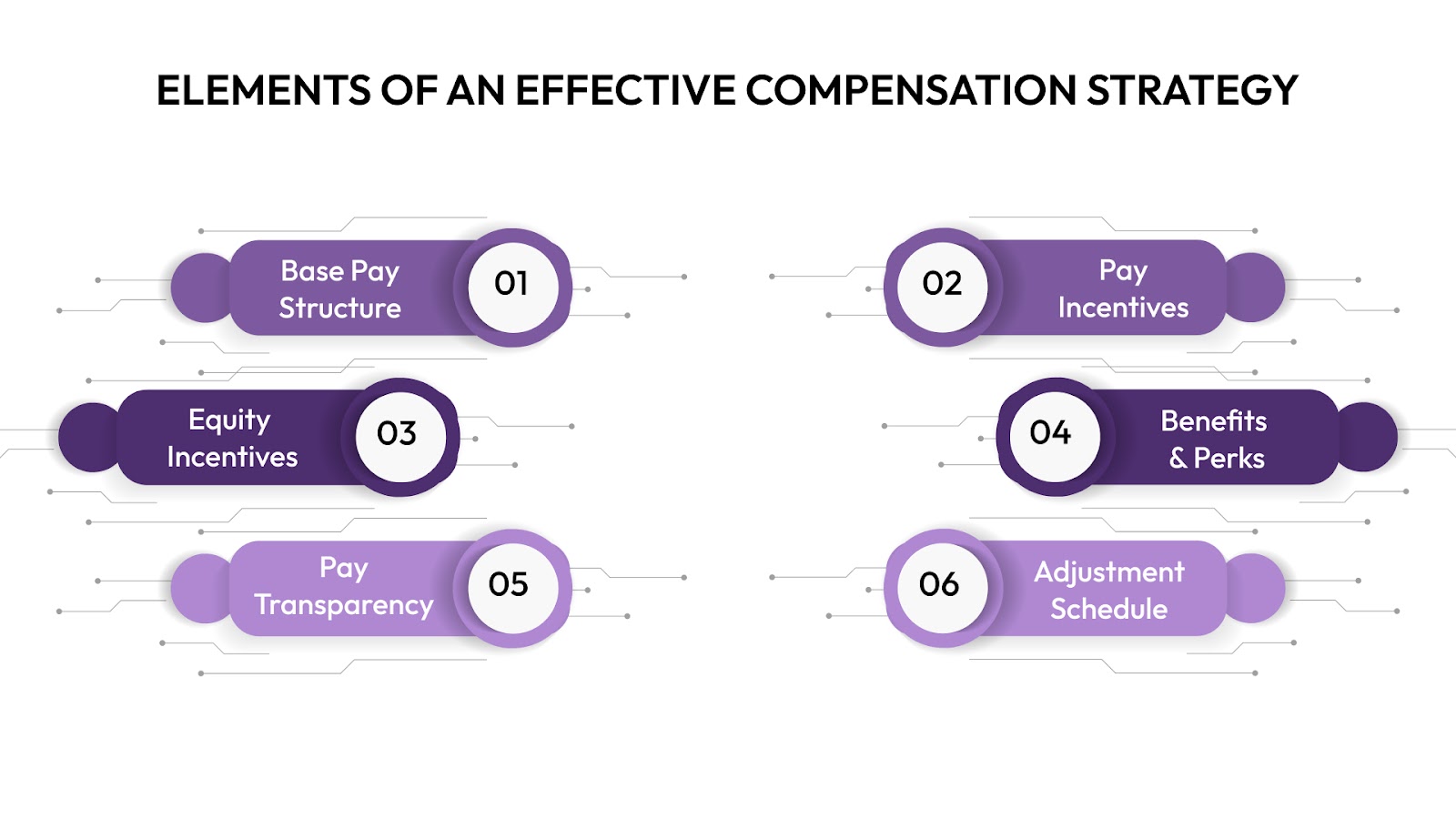
An effective compensation strategy is more than just setting salaries. It’s a well-rounded approach that aligns business goals with employee expectations while staying compliant with labor regulations and competitive within the market.
Here are the core elements:
- Base Pay Structure: Establish a consistent framework based on job roles, market benchmarks, and internal parity. It provides predictability and helps avoid pay compression.
- Variable Pay and Incentives: Include performance bonuses, profit sharing, and commissions that directly reward outcomes and encourage high performance.
- Equity and Long Term Incentives: Stock options and RSUs (Restricted Stock Units) promote long term alignment and retention, especially in startups and growth stage companies.
- Benefits and Perks: Go beyond salary with offerings like health insurance, retirement plans, wellness support, and flexible work policies. These non cash benefits can heavily influence retention.
- Pay Transparency and Communication: Clear communication around how pay is determined builds trust and reduces disengagement. Compensation strategy should be transparent and equitable across departments and levels.
- Review and Adjustment Cadence: Set a regular cadence such as biannual or annual for salary reviews to keep compensation aligned with inflation, performance, and market shifts.
Together, these components make compensation feel intentional, fair, and motivating across all levels of the workforce.

Why Market Benchmarking Is a Must-Have
To retain top talent, your compensation strategy needs to reflect what the market is offering for similar roles and skills. Without benchmarking, it's easy to underpay and lose key performers or overpay and strain budgets unnecessarily.
Key reasons to benchmark compensation regularly:
- Avoid talent loss: Candidates and employees often compare offers using publicly available data. Benchmarking helps you stay competitive and reduce attrition.
- Ensure internal equity: Aligning with external data ensures your pay structure makes sense not just externally, but across departments and roles internally.
- Improve offer acceptance rates: Salary offers that match or exceed market averages are more likely to be accepted, especially in high-demand roles.
- Support budgeting and workforce planning: Market data offers a realistic baseline for salary forecasting and compensation modeling.
- Identify pay gaps and risks: Spot inconsistencies by gender, tenure, or function early and act before they become liabilities.
Want to make smarter, faster compensation decisions with live market data?
Book a demo to see how CandorIQ makes compensation benchmarking effortless and accurate.
Structuring Compensation for Long-Term Retention
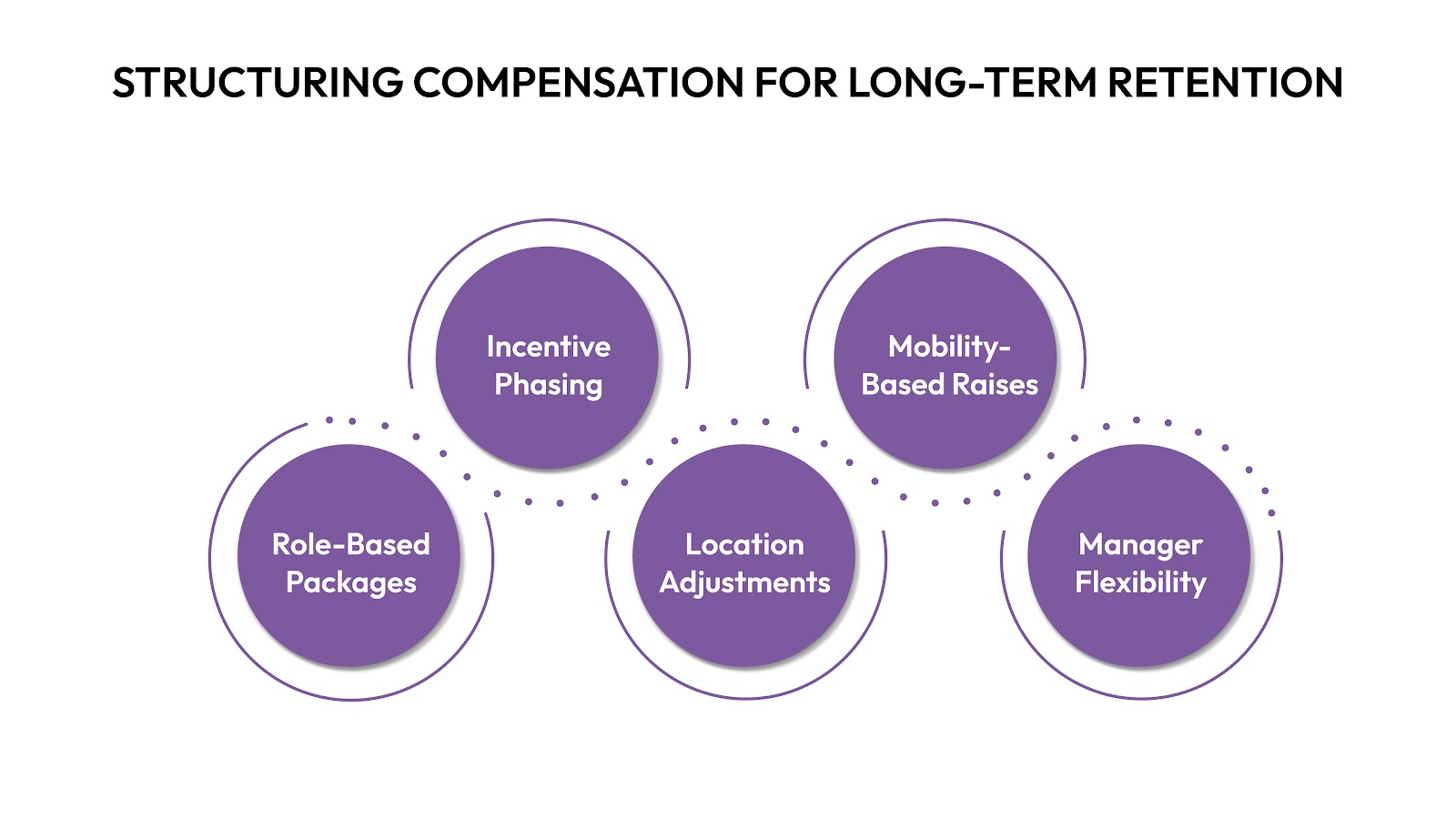
Once you’ve benchmarked compensation against the market, the next step is to structure it in a way that resonates across different employee types, roles, and growth stages. This is where a one-size-fits-all approach often falls short.
Instead, a retention-ready structure considers role-specific needs, career path progression, and long-term alignment with business goals.
Key approaches to compensation structuring that support retention:
- Tailor packages based on role type: Compensation for a software engineer in a product-driven company may lean heavily on equity and performance-based bonuses, while operations roles might prioritize base pay and job stability.
- Introduce phased incentives: Break larger long-term rewards (e.g. RSUs or deferred bonuses) into milestone-based vesting periods. This discourages early exits and keeps employees focused on mid- and long-term goals.
- Adjust for location and market differentials: For hybrid and remote teams, structure pay with geo-based adjustments that ensure fairness without overspending. This becomes essential as more companies hire across regions.
- Link raises to internal mobility: Encourage internal movement and upskilling by designing salary adjustments tied to lateral moves, certifications, or role expansions; not just promotions.
- Support manager-led flexibility within clear frameworks: Allow team leads some discretion in customizing offers, but within a controlled pay band framework to maintain equity and governance.
With a modular structure that flexes by role, geography, and tenure, companies can scale their compensation strategy while retaining fairness and motivation across a diverse workforce.
Making Pay Transparency Work
Pay transparency isn’t just about publishing salary bands. When done well, it builds trust, sets clear expectations, and supports fairness across the organization. But it must be handled with care to avoid confusion or resentment.
Ways to implement pay transparency that supports retention:
- Start with internal alignment: Ensure HR, Finance, and leadership teams agree on pay philosophy and how ranges are defined before communicating with employees.
- Share context, not just numbers: When discussing pay ranges, explain how compensation is determined; based on role level, market benchmarks, and performance.
- Train managers for difficult conversations: Equip team leads to explain pay decisions clearly and confidently to their teams.
- Use structured pay bands: Broad ranges without defined criteria can confuse employees. Structured bands linked to skills, experience, and outcomes work better.
- Revisit and update regularly: Salary benchmarks and business priorities shift. Reviewing ranges annually keeps transparency credible.
Aligning Compensation with Performance
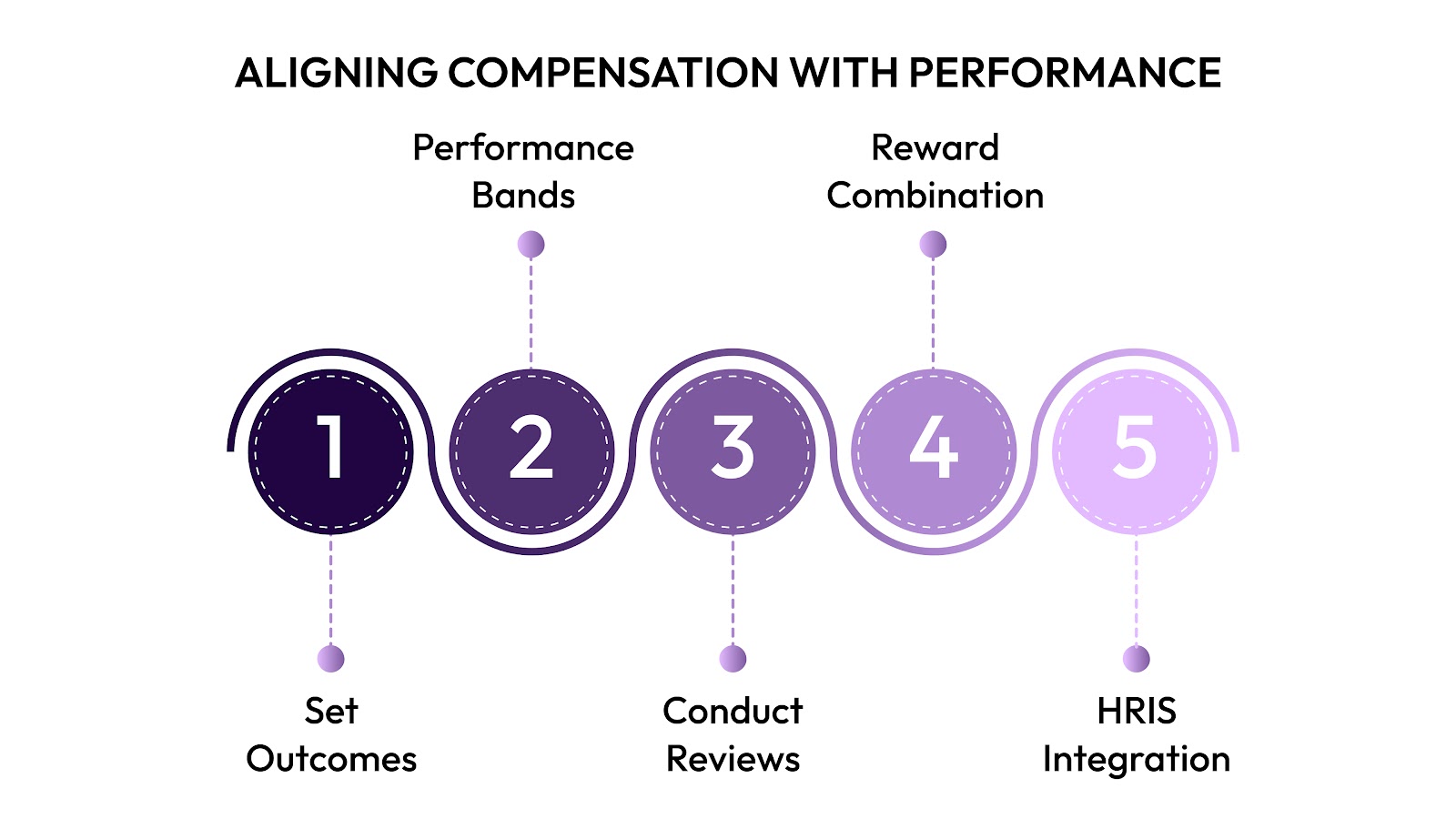
Linking compensation directly to performance helps reinforce a culture of accountability and recognition. It gives high performers a reason to stay and keeps everyone focused on impact.
Key ways to align pay and performance:
- Define measurable outcomes: Tie bonuses, raises, and promotions to clear metrics such as goal completion, project delivery, or client satisfaction.
- Use performance bands: Group employees by performance level and apply differentiated compensation changes within those bands.
- Run regular performance reviews: Annual reviews are not enough in fast-scaling companies. Use quarterly or bi-annual cycles for timely alignment.
- Combine monetary and non-monetary rewards: Bonuses are great, but career progression, visibility, and development opportunities often matter more to top performers.
- Integrate with your HRIS or compensation tool: Ensure your system reflects performance data accurately to inform compensation decisions in real time.
Ready to link performance outcomes to compensation with confidence and clarity?
Schedule a demo with CandorIQ and explore how real-time performance data can power your pay decisions.
Leveraging Technology and Data-Driven Incentives
Modern compensation strategies aren’t static. They’re powered by tools and data that enhance governance, efficiency, and employee trust. For growth-minded leaders, adopting intelligent systems can transform compensation from a manual task into a strategic asset.
- AI-Enabled Benchmarking and Geo-Adjusted Pay: Leading platforms now integrate AI to continuously benchmark external pay, flag market shifts, and recommend geo-adjusted packages. A survey found 22% of companies use AI for external benchmarking and 63% are considering it. With automated alerts, HR can ensure pay bands reflect current market trends, minimizing lag and preserving competitiveness.
- Automating Incentive Structures and “Golden Handcuffs”: "Golden handcuffs" such as deferred equity, retention bonuses, or phantom stock lock in key talent through vesting tied to tenure or performance. Compensation tools can automate these schedules, calculate vesting triggers, and forecast payout liabilities, supporting both employee retention and financial planning without manual overhead.
- Integration with Performance Data and Compensation Governance: To link compensation with outcomes, tech platforms sync with HRIS or performance management systems to pull performance ratings, manager feedback, and objective results. This enables real-time visualization of who qualifies for bonuses or adjustments based on predefined rules, removing biases and enforcing pay equity across demographics and departments.
- Pay Fairness Audits and DEI Insights: Powerful dashboards can identify pay gaps by gender, ethnicity, or geography. While AI speeds detection, CandorIQ emphasizes human oversight to interpret anomalies and take action, creating fair pay structures and building trust internally.
- Efficiency and Collaboration in Compensation Planning: Rather than relying on siloed spreadsheets, compensation platforms offer multi-stakeholder workflows. HR, finance, and business leaders can collaborate on budgets, approve exceptions, and maintain audit trails in one centralized interface. This ensures alignment, transparency, and faster cycle times, especially in scaling companies.
Why This Matters for Talent Strategy
By integrating technology into compensation:
- Leaders stay agile, benchmark shifts, and adjust pay proactively
- High-performers feel rewarded and retained, thanks to transparent, automated incentives
- Organizations uphold governance and equity, reducing compliance risks and building trust
Tech-powered compensation is no longer a nice-to-have. It is essential for retention in fast-scaling firms and speaks directly to the kind of intelligence and visibility platforms like CandorIQ are built to deliver.
How CandorIQ Powers Scalable, Retention-Ready Compensation Strategies
Compensation decisions are no longer just about annual reviews or isolated salary adjustments. In today’s fast-scaling organizations, they demand a coordinated, data-informed approach that is agile, equitable, and directly tied to business goals. That is where CandorIQ comes in.
CandorIQ helps HR, finance, and people leaders replace spreadsheets with a centralized compensation platform designed for high-growth environments. Whether you are planning pay bands, modeling merit cycles, or running equity audits, CandorIQ brings every moving part of compensation into one unified workspace.
Here’s how CandorIQ strengthens your retention strategy:
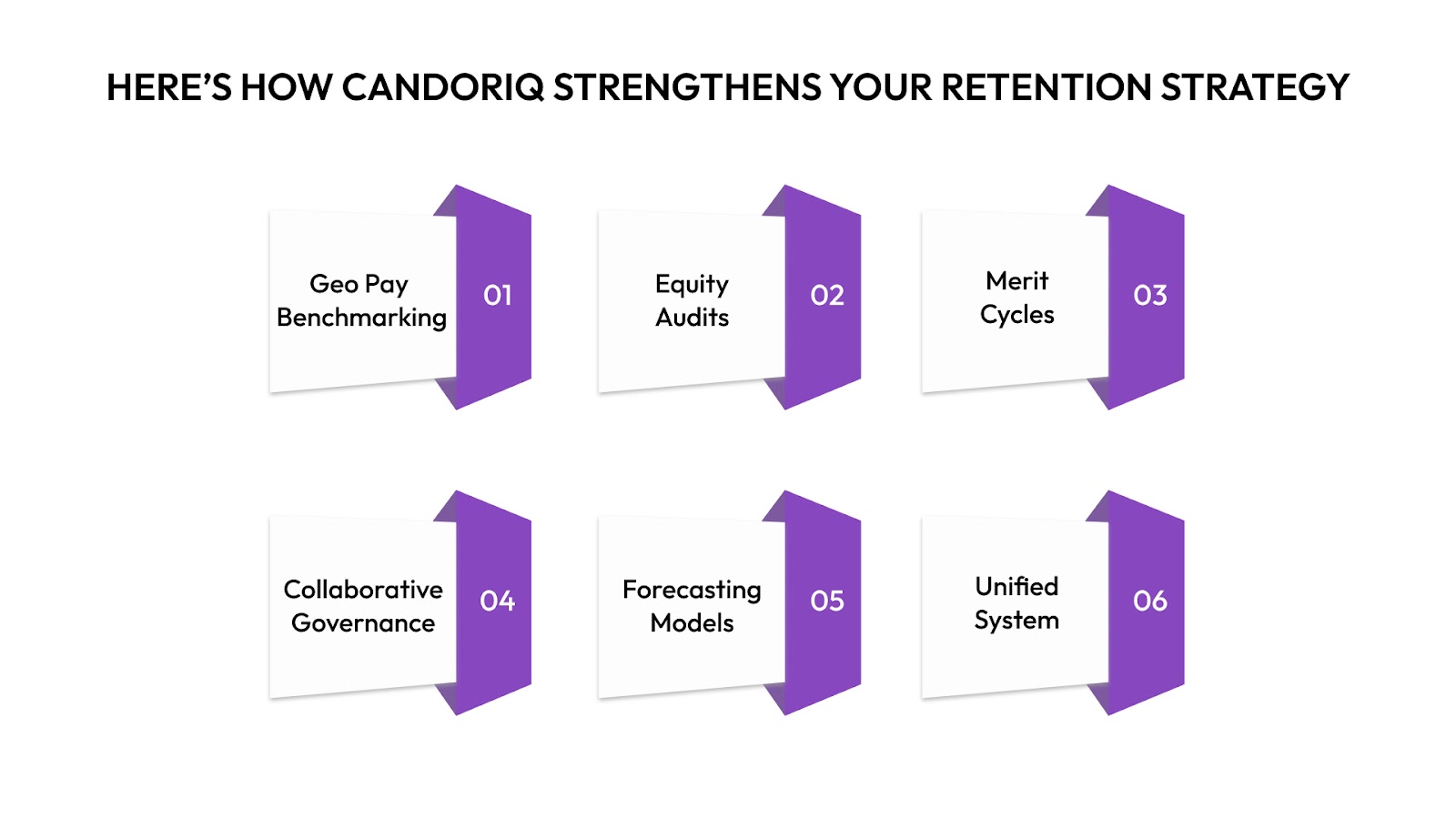
- Geo Adjusted Pay and Benchmarking: Access real-time, role-specific market benchmarks across locations. CandorIQ automatically factors in geographic differentials to help you stay competitive without overspending.
- Pay Equity and DEI Audits: Get visibility into pay gaps by gender, race, or location. Built-in reporting supports equitable decision-making and aligns with your DEI goals without manual analysis.
- Performance Linked Merit Cycles: Seamlessly integrate performance ratings, feedback, and goal completion data into compensation cycles. CandorIQ lets you run merit adjustments and bonus decisions based on real-time inputs.
- Governance and Collaboration: Enable finance, HR, and department heads to work together within guardrails. Set approval workflows, track exceptions, and maintain full audit trails to ensure compliance and accountability.
- Scenario Modeling and Forecasting: Test the financial impact of proposed raises, new hires, or retention plans before implementation. With CandorIQ’s modeling tools, leaders can plan proactively rather than reactively.
- One System and One Source of Truth: From salary bands to promotion-linked raises, all compensation data lives in a single system. This reduces errors, increases transparency, and empowers managers with the clarity they need during reviews.
CandorIQ is built for companies where headcount is growing fast, but governance and retention cannot afford to fall behind. Whether you are preparing for your next compensation cycle or rethinking pay equity from the ground up, CandorIQ helps you move fast without sacrificing fairness or clarity.
See how leading HR and finance teams are modernizing compensation strategy without complexity.
Book your free CandorIQ demo and build a pay system designed for retention and scale.
Final Thoughts
In a competitive talent market, compensation is no longer just an HR function. It is a strategic driver of retention, performance, and organizational growth. From fair base pay and market-aligned bonuses to transparency and tech-enabled planning, the most effective compensation strategies are the ones that scale with your people.
CandorIQ helps you turn these strategies into action. With real-time insights, centralized workflows, and built-in equity governance, you can make smarter compensation decisions that retain top talent and support long-term growth.
Ready to modernize your compensation strategy? Learn how CandorIQ can help you build a more equitable, performance-driven, and retention-focused approach to pay.

Frequently Asked Questions
Q: What is a compensation management strategy?
Ans: A compensation management strategy is a structured approach to how an organization sets, adjusts, and communicates employee pay. It includes base salaries, bonuses, equity, benefits, and performance-based rewards. The goal is to attract, retain, and motivate talent while maintaining internal equity and aligning with business goals.
Q: How does compensation impact employee retention?
Ans: Employees who feel fairly compensated are more likely to stay with an organization. Compensation affects job satisfaction, motivation, and trust in leadership. When pay is competitive, transparent, and tied to performance or growth, retention improves significantly.
Q: What are the key components of an effective compensation strategy?
Ans: An effective strategy includes base pay structure, variable pay and incentives, long-term equity options, benefits and perks, market benchmarking, pay transparency, and regular review cycles. Technology platforms like CandorIQ can help manage and optimize each of these components.
Q: How often should companies review compensation structures?
Ans: At a minimum, companies should review compensation annually. However, in fast-scaling or high-inflation environments, biannual or quarterly reviews are more effective. Regular assessments help maintain competitiveness, close pay gaps, and support agile planning.
Q: What is market benchmarking in compensation?
Ans: Market benchmarking compares internal salaries with external data for similar roles and skills across geographies. It ensures pay stays competitive, avoids over or under-compensation, and supports equity across roles and departments.
Q: How can technology improve compensation planning?
Ans: Technology platforms like CandorIQ consolidate compensation data, automate merit cycles, run pay equity audits, and model various compensation scenarios. This helps HR and finance leaders make faster, data-driven, and compliant decisions.
Q: Can compensation strategies support diversity and inclusion goals?
Ans: Yes. Compensation data can highlight pay disparities by gender, race, or region. With the right tools, companies can proactively close gaps and ensure that pay practices support DEI objectives while building employee trust.
Q: What should companies consider when offering performance-based pay?
Ans: Performance pay should be tied to clear, measurable outcomes. It is important to define goals, use consistent evaluation criteria, and communicate expectations upfront. Combining monetary rewards with development opportunities enhances impact.


